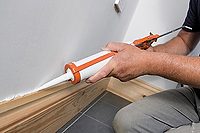Sealant Solution

Over the years, many types of liquid-applied sealants have been used in the construction industry. These "wet sealants" include acrylics, polyurethanes, polysulfides, silicones and other technologies. While these wet sealants have been used successfully for many years, the advantages of pre-cured joint sealants are bolstering their popularity. Pre-cured joint sealants are produced by extruding material similar to wet sealant and allowing it to cure to an elastomeric product in a controlled manufacturing environment. They are packaged in cured form, often in rolls, instead of in liquid form (tubes, pails, etc.) like standard wet sealants. Pre-cured joint sealants are installed using a thin layer of wet sealant on the edges as an adhesive to attach the material to the substrate it is sealing.





This system for repairing failed sealant joints is especially useful with soft and sensitive substrates, such as EIFS and natural stone. With these types of soft building materials, removal of the old sealant will damage the substrate and ruin the integrity of the joint. Since the old sealant and substrate are not disturbed during application, pre-cured silicone sealants are also beneficial in applications where the old sealant and/or substrate may contain hazardous materials, such as asbestos or PCBs.

Another situation where pre-cured silicone sealants are used instead of wet-sealant joints occurs when joint width is not adequate to handle the joint movement. This occurs frequently in buildings that are lacking an ample number of expansion joints on the exterior substrate, causing the joints to expand and contract beyond the movement capability of the wet sealant. Another example is found in window perimeters where the opening does not leave adequate space around the window for a working sealant joint. Because the sealant adhesive is only used on the edges of the material, the pre-cured silicone sealant system creates its own joint width to handle the movement experienced by the substrate in these situations.
Besides remedial work over failed sealant in expansion joints and butt-joint applications, pre-cured silicone sealants are used successfully in many other applications, including the following.
- Window perimeter seals
- Aluminum window systems
- Roofing and parapet seals
- Curtainwall seals
- Skylights
- RV, marine and transportation seals
- HVAC system seals
- Fillet beads for showers/tubs
As pre-cured silicone sealants have become more accepted by the construction industry, manufacturers have made an effort to continually improve and expand their product lines. Today, there are many more standard sizes and colors available, as well as custom colors and widths. Custom-designed materials can be produced with one or more notches in the extrusion. These notches allow pre-cured silicone sealant to follow complex bends on a building in applications such as inside and outside corners, parapet caps, and window mullions. Materials with surface textures designed to match the appearance of EIFS, stucco and many other surfaces are also available.
Pre-cured silicone sealants have been successfully used in renovations and remedial construction applications for many years, and are becoming accepted by the industry as a viable alternative to removing failed sealant. Consequently, more contractors, consultants, architects and specifiers are realizing the benefits of using pre-cured silicone sealant, allowing for applications in new builds as well. For example, it is thought that the use of pre-cured silicone sealants could lead to a change in basic joint design in new construction projects.
As leaders in the industry begin to realize the impact that cost savings and product performance can have, it is expected that the market share for pre-cured silicone sealant will continue to grow. The scope and magnitude of the use of pre-cured silicone sealants in construction and other industries will greatly depend upon the collaboration of contractors, specifiers, architects, consultants, and manufacturers.
For more information, contact Sealex Inc., 8850 Moeller Drive, Harbor Springs, MI 49740; phone (231) 348-5020; fax (231) 348-5255; e-mail jbakus@sealexinc.com; or visit http://www.sealexinc.com.
Looking for a reprint of this article?
From high-res PDFs to custom plaques, order your copy today!




